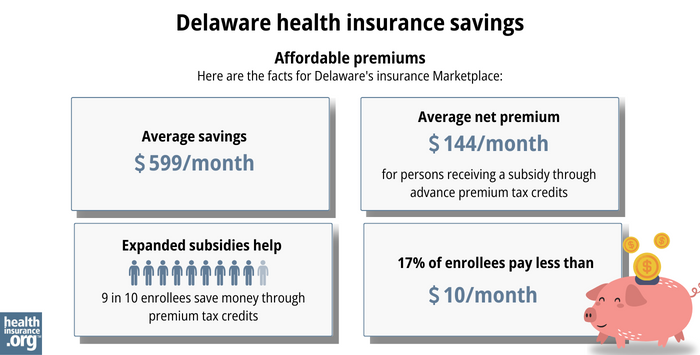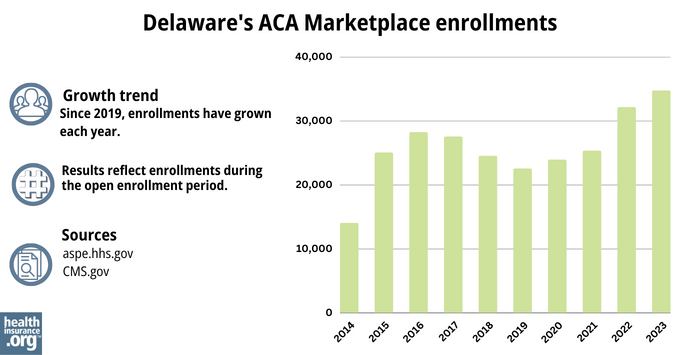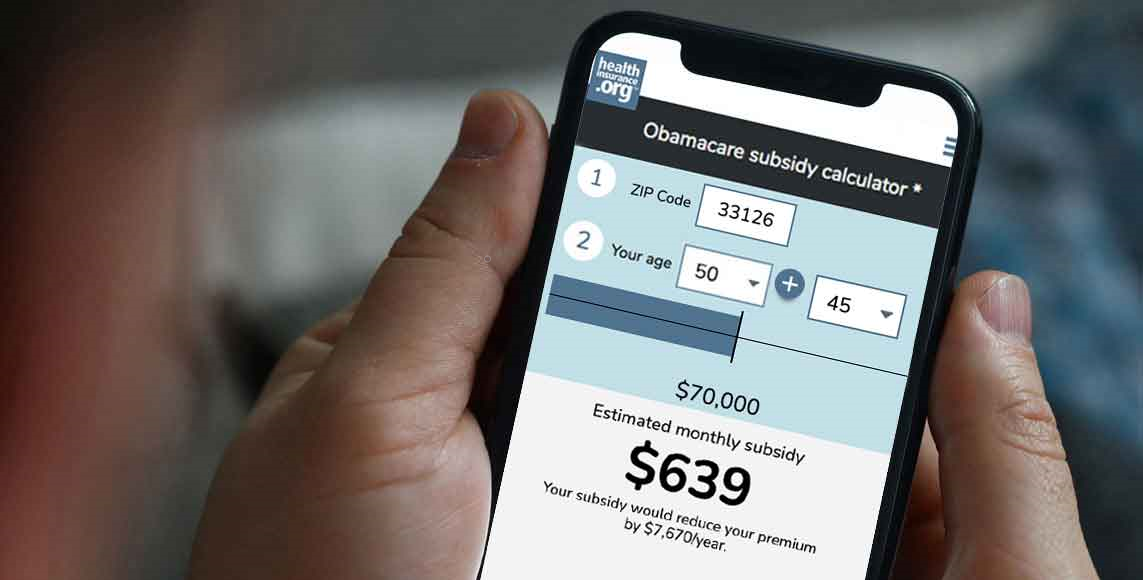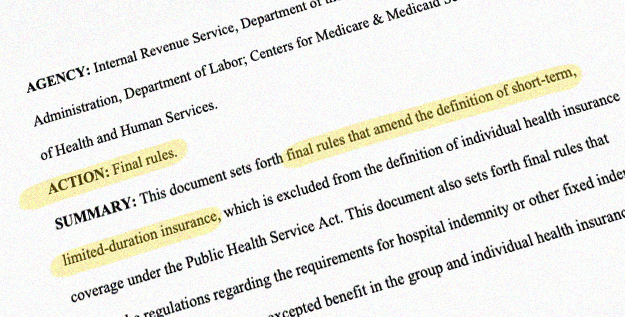Home > States > Health insurance in Delaware
See your Delaware health insurance coverage options.

Find individual and family plans, small-group, short-term or Medicare plans through licensed agency partners.

Delaware Health Insurance Consumer Guide
We’ve created this guide, including the FAQs below, to help you understand the health insurance options available to you and your family in Delaware.
ACA Marketplace (exchange) plans – or Obamacare – are available for people who need to buy their own health coverage, including those who aren’t eligible for Medicare, Medicaid, or employer-sponsored coverage.
Delaware has a partnership exchange. The state runs Choose Health Delaware – an informational website – and the federally run Marketplace platform, HealthCare.gov, is used for enrollment. Delaware residents who need to obtain their own health insurance can use HealthCare.gov to shop for individual and family health coverage offered by various private health insurers.
For several years, there was only one insurance company that offered individual/family coverage through Delaware’s exchange. But four insurance companies are offering coverage for 2024, including another new carrier.
Explore our other comprehensive guides to coverage in Delaware
Dental coverage in Delaware

Looking to improve your smile and save some money at the dentist’s office? A dental insurance policy might be a good choice, in addition to your medical coverage. Our guide explores dental coverage options in Delaware.

Delaware’s Medicaid program

Delaware expanded Medicaid eligibility under the ACA, starting in 2014. By April 2023, more than 308,000 people were enrolled in Delaware Medicaid/CHIP (Delaware Health Children) – a 38% increase since 2013.1 After being paused for three years during the pandemic, Medicaid disenrollments resumed in Delaware in June 2023. By August, more than 22,000 people had been disenrolled from the program.2

Medicare coverage and enrollment in Delaware

More than 234,000 Delaware residents were enrolled in Medicare as of May 2023. Most are eligible due to age, but about 24,000 are under 65 and eligible due to a disability.3 Our Delaware Medicare guide explains what you need to know about the various parts of Medicare, as well as Delaware’s regulations pertaining to Medicaid availability.

Short-term coverage in Delaware

Delaware allows short-term health plans to have durations of up to three months, and renewals are prohibited. There are at least three insurers that offer short-term plans in the state.4

Frequently asked questions about health insurance in Delaware
Who can buy Marketplace health insurance?
In order to sign up for private health coverage through the Marketplace in Delaware, you must:
- Live in Delaware and be lawfully present in the United States
- Not be incarcerated
- Not be enrolled in Medicare
By those rules, most Delaware residents qualify to use the Marketplace.5 But a more important question for most people is eligibility for financial assistance, and there are a few additional parameters in order to qualify for subsidies in the Marketplace. To be eligible for income-based Advance Premium Tax Credits (APTC) or cost-sharing reductions (CSR), you must:
- Not be eligible to enroll in affordable health coverage offered by an employer. If you have access to an employer’s plan but it seems too expensive, you can use our Employer Health Plan Affordability Calculator to see if you might qualify for premium subsidies in the Marketplace.
- Not be eligible for Medicaid or CHIP.
- Not be eligible for premium-free Medicare Part A.6
In addition to those basic parameters, eligibility for Marketplace subsidies depends on your household income and how it compares with the cost of the second-lowest-cost Silver plan in your area (the cost of this plan will depend on your age and location).
When can I enroll in an ACA-compliant plan in Delaware?
You can sign up for an ACA-compliant individual or family health plan in Delaware between November 1 and January 15, the annual open enrollment period.7
To have a January 1 coverage effective date, you need to complete your application by December 15. Plan selections made between December 16 and January 15 will have a February 1 coverage effective date.8
Outside of the annual open enrollment window, you may still be eligible to enroll or make a plan change if you experience a qualifying life event, such as giving birth or losing other health coverage. And some people can enroll year-round even without a specific qualifying life event.
Enrollment in Delaware Medicaid/CHIP is available year-round.
How do I enroll in a Delaware Marketplace plan?
To enroll in an ACA Marketplace plan in Delaware, you can:
- Visit HealthCare.gov to compare plans, see your subsidy eligibility (if applicable), and enroll in the plan that best meets your needs.
- Use the state-run Choose Health Delaware website to learn about the available health plans. You’ll be directed to the HealthCare.gov platform in order to enroll.
- Purchase Marketplace coverage with the help of an insurance agent or broker, Navigator, or certified application counselor. These individuals can provide help online, over the phone, or in-person.
- Enroll via an approved enhanced direct enrollment entity.9
You can reach HealthCare.gov’s call center by dialing 1-800-318-2596 (TTY: 1-855-889-4325). The call center is available 24 hours a day, seven days a week, except holidays.
How can I find affordable health insurance in Delaware?
The Affordable Care Act (ACA) created income-based subsidies that can help lower your premium payments each month. These subsidies are available to Delaware residents who meet the eligibility requirements and enroll in Marketplace coverage.
As of 2023, nine out of ten Marketplace enrollees in Delaware were receiving premium subsidies. The subsidies reduced their average health insurance premiums by $599/month. After subsidies were applied, the average Delaware Marketplace enrollee’s premium was about $144/month.10

Source: CMS.gov10
Reinsurance: Delaware has a reinsurance program, which has helped to keep full-price premiums lower than they would otherwise have been over the last few years. Although the majority of Delaware’s Marketplace enrollees qualify for premium subsidies, the reinsurance program keeps coverage more affordable than it would otherwise be for those who aren’t subsidy-eligible.11
Cost-sharing reductions: If your household income is no more than 250% of the federal poverty level, you may also be eligible for cost-sharing reductions (CSR), as long as you select a Silver-level plan. These subsidies result in lower out-of-pocket costs, including deductibles. As of 2023, more than a quarter of Delaware’s Marketplace enrollees were receiving CSR benefits.10
Medicaid/CHIP: Depending on your income and circumstances, you may be able to enroll in free or low cost health coverage through Medicaid or CHIP (Delaware Healthy Children). Check to see if you meet the criteria for Delaware Medicaid/CHIP.
Insulin cost-sharing cap: Delaware caps insulin out-of-pocket costs at $35/month for people with state-regulated health insurance, which includes Marketplace plans.12 And cost-sharing for specialty drugs is capped at no more than $150/month for Delaware residents enrolled in state-regulated health plans.13
How many insurers offer Marketplace coverage in Delaware?
Four insurers offer individual/family coverage through the Delaware Marketplace for 2024, including one newcomer, Celtic.14
Are Marketplace health insurance premiums increasing in Delaware?
The following table highlights each Delaware Marketplace insurer’s approved rate changes for 2024 individual/family health plans.
Delaware’s ACA Marketplace Plan 2024 Approved Rate Increases by Insurance Company |
|
|---|---|
| Issuer | Percent Increase |
| Aetna Health | 2% |
| AmeriHealth Caritas | -4.5% |
| Highmark BCBSD | 3.2% |
| Celtic | (New for 2024) |
Source: Delaware Department of Insurance15
(Note that the approved rate increase for Highmark was a little lower than the insurer initially proposed. Rate filings are reviewed and finalized by the Delaware Department of Insurance.)
It’s important to keep in mind that average rate changes are calculated based on full-price premiums, and most enrollees do not pay full price: As of 2023, nine out of ten Delaware Marketplace enrollees were receiving premium subsidies that reduced their monthly payments.10
For perspective, here’s an overview of how average full-price premiums have changed in Delaware over time:
- 2015: Average increase of 3%16
- 2016: Average increase of 22%17
- 2017: Average increase of 30%18
- 2018: Average increase of 25%19
- 2019: Average increase of 3%20
- 2020: Average decrease of 19%21 (reinsurance program took effect)
- 2021: Average decrease of 1%22
- 2022: Average increase of 3%23
- 2023: Average increase of 5.5%24 (plus two new insurers)
How many people are insured through Delaware’s Marketplace?
During the open enrollment period for 2024 coverage, 44,842 people enrolled in private health plans through the Delaware Marketplace.25
This was a significant record high, far exceeding the previous record high set the year before, when 34,742 people selected private plans through Delaware’s Marketplace.10

Source: 2014,26 2015,27 2016,28 2017,29 2018,30 2019,31 2020,32 2021,33 2022,34 202310
The enrollment growth in recent years, illustrated above, stems in large part from the subsidy enhancements created by the Amerian Rescue Plan and Inflation Reduction Act.
The enrollment growth in 2024 is also partially due to the “unwinding” of the pandemic-era continuous coverage rule for Medicaid, which prevented Medicaid disenrollments for three years. By September 2023, more than 3,000 people in Delaware had transitioned from Medicaid to a Marketplace plan.35
What health insurance resources are available to Delaware residents?
HealthCare.gov
This is the Marketplace enrollment platform in Delaware. Residents can use it to enroll in individual/family health plans and receive income-based subsidies. You can contact HealthCare.gov at 800-318-2596.
Choose Health Delaware
Delaware’s partnership exchange/Marketplace. Helps consumers learn about coverage options in the Marketplace, and directs them to HealthCare.gov for enrollment.
Quality Insights, Inc.
Delaware’s federally funded Navigator organization, helping residents find affordable coverage through the Marketplace and the state’s Medicaid/CHIP program.
Delaware Health and Social Services
Administers Medicaid and Delaware Healthy Children (CHIP), as well as other social services programs.
Delaware Department of Insurance
Regulates and oversees the insurance industry in Delaware, and assists consumers and businesses with insurance-related questions and concerns.
Delaware Medicare Assistance Bureau
A resource for Delaware Medicare beneficiaries and their caregivers. Provides information and assistance with questions related to Medicare eligibility, enrollment, and claims.
Louise Norris is an individual health insurance broker who has been writing about health insurance and health reform since 2006. She has written dozens of opinions and educational pieces about the Affordable Care Act for healthinsurance.org.
Footnotes
- "Total Monthly Medicaid and CHIP enrollment and Pre-ACA enrollment" KFF, April 2023 ⤶
- "Medicaid Continuous Coverage Unwinding Renewals Reporting" Delaware Health and Social Services. August 2023 ⤶
- "Medicare Monthly Enrollment" CMS.gov, May 2023 ⤶
- “Availability of short-term health insurance in Delaware” healthinsurance.org, July 5, 2023 ⤶
- ”A quick guide to the Health Insurance Marketplace” HealthCare.gov ⤶
- Medicare and the Marketplace, Master FAQ. Centers for Medicare and Medicaid Services. Accessed November 2023. ⤶
- ”A Quick Guide to the Health Insurance Marketplace; When Can You Get Health Insurance?” HealthCare.gov ⤶
- “When can you get health insurance?” HealthCare.gov, 2023 ⤶
- “Entities Approved to Use Enhanced Direct Enrollment” CMS.gov, April 28, 2023 ⤶
- “2023 Marketplace Open Enrollment Period Public Use Files” CMS.gov, March 2023 ⤶ ⤶ ⤶ ⤶ ⤶ ⤶
- Reinsurance Program. Delaware.gov. Accessed December 2023. ⤶
- ”Delaware Caps Monthly Cost of Diabetes Supplies at $35” DiaTribeLearn. November 2022 ⤶
- ”Prescription Drug Spending and Rebates in Delaware” Delaware Department of Insurance, July 2022 ⤶
- 2024 Health Insurance Rate Filings. Delaware Department of Insurance. Accessed November 2023. ⤶
- 2024 Health Insurance Rate Filings. Delaware Department of Insurance. Accessed November 2023. ⤶
- ”Analysis Finds No Nationwide Increase in Health Insurance Marketplace Premiums” The Commonwealth Fund. December 2014 ⤶
- ”FINAL PROJECTION: 2016 Weighted Avg. Rate Increases: 12-13% Nationally*” ACA Signups. October 2015 ⤶
- ”Avg. UNSUBSIDIZED Indy Mkt Rate Hikes: 25% (49 States + DC)” ACA Signups. October 2016 ⤶
- ”Highmark’s Obamacare policies to rise 25 percent in Delaware” Delaware Online. October 5, 2017 ⤶
- ”Final ACA Individual Rate Increase 3% / Highmark to Rebate Over $5 Million to Small Groups” Delaware Department of Insurance ⤶
- ”Nov 1 – Dec 15: Open Enrollment for Delaware’s Health Insurance Marketplace” Delaware Department of Insurance ⤶
- ”Rates To Decrease In Delaware Affordable Care Act Marketplace” Delaware Department of Insurance ⤶
- ”2022 Highmark BCBSD – Individual (Marketplace) Plans” Delaware Department of Insurance ⤶
- ”2023 Highmark BCBSD – Individual (Marketplace) Plans” Delaware Department of Insurance ⤶
- Marketplace 2024 Open Enrollment Period Report: Final National Snapshot. Centers for Medicare and Medicaid Services. January 2024. ⤶
- “ASPE Issue Brief (2014)” ASPE, 2015 ⤶
- “Health Insurance Marketplaces 2015 Open Enrollment Period: March Enrollment Report”, HHS.gov, 2015 ⤶
- “HEALTH INSURANCE MARKETPLACES 2016 OPEN ENROLLMENT PERIOD: FINAL ENROLLMENT REPORT” HHS.gov, 2016 ⤶
- “2017 Marketplace Open Enrollment Period Public Use Files” CMS.gov, 2017 ⤶
- “2018 Marketplace Open Enrollment Period Public Use Files” CMS.gov, 2018 ⤶
- “2019 Marketplace Open Enrollment Period Public Use Files” CMS.gov, 2019 ⤶
- “2020 Marketplace Open Enrollment Period Public Use Files” CMS.gov, 2020 ⤶
- “2021 Marketplace Open Enrollment Period Public Use Files” CMS.gov, 2021 ⤶
- “2022 Marketplace Open Enrollment Period Public Use Files” CMS.gov, 2022 ⤶
- HealthCare.gov Marketplace Medicaid Unwinding Report. Centers for Medicare and Medicaid Services. Data through September 2023. ⤶







